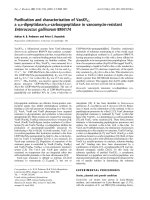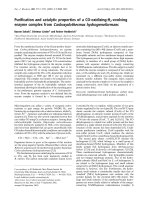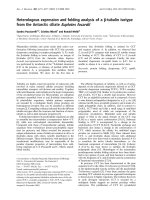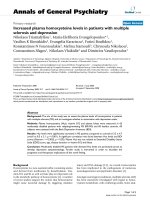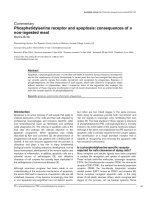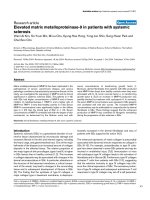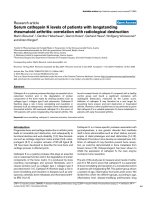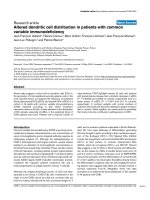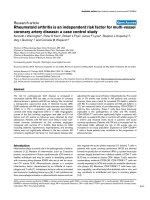Báo cáo y học: "Serum proteins and paraproteins in women with silicone implants and connective tissue disease: a case–control study" pot
Bạn đang xem bản rút gọn của tài liệu. Xem và tải ngay bản đầy đủ của tài liệu tại đây (367.46 KB, 10 trang )
Open Access
Available online />Page 1 of 10
(page number not for citation purposes)
Vol 9 No 5
Research article
Serum proteins and paraproteins in women with silicone implants
and connective tissue disease: a case–control study
Gyorgy Csako
1
, Rene Costello
1
, Ejaz A Shamim
2
, Terrance P O'Hanlon
2
, Anthony Tran
1,3
,
Daniel J Clauw
4
, H James Williams
5
and Frederick W Miller
2
1
Department of Laboratory Medicine, Clinical Center, NIH, DHHS, 9000 Rockville Pike, Bethesda, MD 20892, USA
2
Environmental Autoimmunity Group, National Institute of Environmental Health Sciences, NIH, DHHS, 9000 Rockville Pike, Bethesda, MD 20892,
USA
3
Association of Public Health Laboratories, 8515 Georgia Avenue, Suite 700, Silver Spring, MD 20910, USA
4
Division of Rheumatology, Department of Medicine, University of Michigan Medical School, 101 Simpson Drive, Ann Arbor, MI 48109, USA
5
Division of Rheumatology, Department of Internal Medicine, University of Utah Medical Center, 50 North Medical Drive, Salt Lake City, UT 84132,
USA
Corresponding author: Gyorgy Csako,
Received: 30 Apr 2007 Revisions requested: 19 Jun 2007 Revisions received: 9 Aug 2007 Accepted: 17 Sep 2007 Published: 17 Sep 2007
Arthritis Research & Therapy 2007, 9:R95 (doi:10.1186/ar2295)
This article is online at: />© 2007 Csako et al., licensee BioMed Central Ltd.
This is an open access article distributed under the terms of the Creative Commons Attribution License ( />),
which permits unrestricted use, distribution, and reproduction in any medium, provided the original work is properly cited.
Abstract
Prior studies have suggested abnormalities of serum proteins,
including paraproteins, in women with silicone implants but did
not control for the presence of connective-tissue disease (CTD).
This retrospective case–control study, performed in tertiary-care
academic centers, assessed possible alterations of serum
proteins, including paraproteins, in such a population. Seventy-
four women with silicone implants who subsequently developed
CTD, and 74 age-matched and CTD-matched women without
silicone implants, were assessed in the primary study; other
groups were used for additional comparisons. Routine serum
protein determinations and high-sensitivity protein
electrophoresis and immunofixation electrophoresis were
performed for detection of paraproteins. Women with silicone
implants, either with or without CTD, had significantly lower
serum total protein and α
1
-globulin, α
2
-globulin, β-globulin, γ-
globulin, and IgG levels compared with those without silicone
implants. There was no significant difference, however, in the
frequency of paraproteinemia between women with silicone
implants and CTD (9.5%) and age-matched and CTD-matched
women without silicone implants (5.4%) (odds ratio, 1.82; 95%
confidence interval, 0.51–6.45). Paraprotein isotypes were
similar in the two groups, and the clinical characteristics of the
13 women with paraproteinemia were comparable with an
independent population of 10 women with silicone breast
implants, CTD, and previously diagnosed monoclonal
gammopathies. In summary, this first comprehensive study of
serum proteins in women with silicone implants and CTD found
no substantially increased risk of monoclonal gammopathy.
Women with silicone implants, however, had unexpectedly low
serum globulin and immunoglobulin levels, with or without the
subsequent development of CTD. The causes and clinical
implications of these findings require further investigation.
Introduction
Local adverse effects from silicone implants, which include
surgically placed devices as well as injections of liquid sili-
cone, are well recognized [1,2], but systemic effects are not
supported by current studies. Systematic reviews [3,4] and
four meta-analyses including data from up to 20 retrospective
cohort, case–control, and cross-sectional studies [5-8] have
failed to find significantly increased risks of any CTD after
receiving silicone implants.
Few studies, however, have evaluated serum proteins and par-
aproteins in women with silicone implants. Plasmacytomas
have been induced with silicone gel from breast implants in
susceptible mouse strains [9], and several uncontrolled clini-
cal reports suggested that silicone implants might be associ-
ated with multiple myeloma (MM) and its possible precursor,
monoclonal gammopathy of undetermined significance
(MGUS) [10-12]. One investigation evaluated the risk for
MGUS in a retrospective case–control study of women with
CTD = connective tissue disease; FDA = US Food and Drug Administration; FMS = fibromyalgia syndrome; MGUS = monoclonal gammopathy of
undetermined significance; MM = multiple myeloma; NIH = National Institutes of Health; UCTD = undifferentiated connective tissue disease.
Arthritis Research & Therapy Vol 9 No 5 Csako et al.
Page 2 of 10
(page number not for citation purposes)
and without silicone implants, and found a nonsignificant
increase (odds ratio, 1.25; 95% confidence interval, 0.27–
6.39) [13]. Another case–control study found no increase in
immunoglobulin levels or other immunologic parameters, with
the exception of anti-single-stranded DNA autoantibodies, in
women with silicone implants [14]. None of these studies,
however, assessed the role of concomitant CTD, which has
been reported to be a risk factor for monoclonal immunoglob-
ulins (paraproteins) and is associated with MGUS in 3–6% of
cases [15].
The possible increased risk of paraproteins in women with sil-
icone implants and CTD, as well as the limited information on
other serum proteins in this population, prompted us to assess
whether silicone implants in women who subsequently devel-
oped CTD are associated with altered serum protein profiles
and/or a higher prevalence of serum paraproteins.
Materials and methods
Patients and study design
All patients were enrolled prospectively in studies of the patho-
genesis of the diseases described, and extensive clinical infor-
mation was collected at enrollment to ensure subjects met the
diagnostic criteria. The current study was retrospective in that
subjects enrolled in the prior studies were identified based on
the presence of a stored serum sample.
The primary study population (Group 1) included 74 women
who developed CTD after receiving silicone implants. Group 1
were enrolled in studies of the pathogenesis of CTD develop-
ing after receiving silicone implants at the US Food and Drug
Administration (FDA) and the National Institutes of Health
(NIH) from 1993 to 2000. These subjects were matched to 74
age-matched and CTD-matched women without silicone
implants (Group 2) enrolled in other protocols at the FDA and
NIH between 1993 and 2000, and subjects from a study of
the underlying mechanisms of primary fibromyalgia (fibromyal-
gia syndrome (FMS)) from 1986 to 1989 and from the Early
Undifferentiated Connective Tissue Disease study as part of
the Cooperative Systematic Studies of the Rheumatic Dis-
eases enrolled between 1982 and 1987.
We also matched 14 women with silicone implants but no
CTD (Group 3) to 14 women without silicone implants or CTD
(Group 4) for exploratory evaluations of the effects of silicone
implants without CTD. In other exploratory analyses, cases
from Group 2 that were found to have paraproteins were com-
pared with those paraprotein cases in independent groups of
28 women with CTD but without silicone implants (Group 5),
and were compared with 10 women with CTD and previously
diagnosed gammopathies following silicone breast implants
(Group 6). Apart from Group 6, none of the women had been
diagnosed with paraproteinemia previously.
All women gave informed consent to allow their clinical infor-
mation and serum to be used for research purposes in clinical
studies approved by institutional review boards at the FDA, at
the NIH, at Georgetown University, Washington, DC, and at
the University of Utah, Salt Lake City, UT.
Disease classification criteria
Clinical diagnoses for CTD were determined following Ameri-
can College of Rheumatology criteria or were based upon pro-
posed criteria when American College of Rheumatology
criteria were not available for a given condition. Patients with
the following diseases were included in the analyses: definite
or probable polymyositis or dermatomyositis [16], systemic
sclerosis (scleroderma) [17], systemic lupus erythematosus
[18], FMS [19], and undifferentiated connective tissue dis-
ease (UCTD) and unexplained polyarthritis [20]. Disease dura-
tion was defined as the time between onset of disease and
specimen collection.
Selection of women with silicone implants for the case–
control study
As already described, 88 women (Groups 1 and 3) enrolled
into FDA and NIH protocols investigating the pathogenesis of
CTD following silicone implants were chosen for study on the
basis of the presence of documented silicone implants and an
available serum sample collected for research purposes. Sili-
cone implants consisted of surgically placed devices and liq-
uid silicone injections. The most common types of silicone
implants were breast implants (n = 81); these included sili-
cone gel-filled devices (n = 68), saline implants (n = 6), both
polyurethane and silicone gel implants (n = 3), and both poly-
urethane and saline implants (n = 4). Two women with breast
implants also had additional silicone implants (one had liquid
silicone injections and one had bilateral cheek implants). Five
women received only silicone cheek implants. The time of sili-
cone exposure was defined as the time from placement or
injection of the first implant to specimen collection. Silicone
implant duration was defined as the time from placement of the
first implant to removal of the last implant.
Selection of women without silicone implants for the
case–control study
Women without silicone implants consisted of subjects
enrolled into investigations into the natural history of CTD dis-
eases conducted at the FDA and the NIH, of the pathogenesis
of FMS at Georgetown University and of women enrolled in a
multicenter inception cohort of early UCTD who were followed
to assess ultimate clinical outcomes [20].
The 88 women with silicone implants (Groups 1 and 3) were
randomly matched for age and specific CTD (or, as appropri-
ate, for lack of CTD) with women from these populations with-
out silicone implants (Groups 2 and 4). Seventy-five patients
(85%) were matched within 5 years of age, 12 patients (14%)
were matched within 6–10 years, and one patient (1%) was
Available online />Page 3 of 10
(page number not for citation purposes)
matched within 15 years of age. The mean age was 50.2 ± 8.8
years (median 50 years, range 30–76 years) in the silicone
implants group versus 49.4 ± 8.4 years (median 50 years,
range 32–71 years) in those without silicone implants (P =
0.06).
The women were also matched for diagnosis (64 patients with
various inflammatory CTD, 10 patients with noninflammatory
CTD (FMS), and 14 patients without any CTD in both groups).
Except for the single systemic lupus erythematosus subject
with silicone implants, who was matched with a dermatomy-
ositis subject without silicone implants, all matched subjects
shared the same clinical diagnoses. Diagnostic categories
(and the total number of matched women) included UCTD (n
= 78), polymyositis/dermatomyositis (n = 27), FMS (n = 20),
systemic sclerosis (n = 20), unexplained polyarthritis (n = 2),
systemic lupus erythematosus (n = 1), and no CTD (n = 28).
The frequencies of UCTD criteria in the silicone group were:
unexplained polyarthritis, 72%; myalgias, 59%; isolated kera-
toconjunctivitis sicca, 38%; Raynaud's disease, 31%; rash,
31%; central nervous system symptoms, 13%; pulmonary
symptoms, 5%; elevated erythrocyte sedimentation rate, 5%;
false-positive serologic test for syphilis, 5%; and peripheral
neuropathy, 3%.
Although attempts were made to race match whenever possi-
ble, there were more African-Americans and Hispanics in
women without silicone implants (69 Whites, 14 Blacks, three
Hispanics, one Oriental, one unknown race) than in those with
silicone implants (87 Whites, one Hispanic).
Determination of serum total protein and
immunoglobulins
Serum samples were stored at -80°C until analysis and labo-
ratory personnel were blinded to the group identity of the sam-
ples. Total serum protein was measured by a biuret method on
Hitachi 917 automated chemistry analyzers (Roche Diagnos-
tics, Indianapolis, IN, USA). Serum IgG, IgA, and IgM levels
were quantified by immunonephelometry on a protein array
automated immunochemistry analyzer (Beckman-Coulter,
Brea, CA, USA).
Serum protein electrophoresis
For quantification of various protein fractions and paraprotein
bands, all sera first underwent electrophoresis in agarose gel
by a semi-automated electrophoretic system (SPIFE™ SPE
Vis-60; Helena Labs, Beaumont, TX, USA). After staining with
amido black, gels were scanned with an EDC densitometer
(Helena Labs) at 545 nm. As part of the immunofixation elec-
trophoretic screen for paraproteins (see below), all sera also
underwent electrophoresis in agarose gel (Hydragel; Sebia,
Norcross, GA, USA) by another semi-automated electro-
phoretic system (Hydrasys; Sebia, Norcross, GA, USA). This
screen involved the use of a more sensitive protein stain (acid
violet) for improved detection of paraproteins.
Serum immunofixation electrophoresis
After electrophoresis of the sera in agarose gel (Hydrasys;
Sebia, Norcross, GA, USA), immunofixation was performed
first with a mixture of antibodies (anti-α, anti-γ, and anti-μ heavy
chains, and anti-κ and anti-λ free light chains) (Penta screen;
Sebia, Norcross, GA, USA). Patterns were visualized by stain-
ing with a highly sensitive protein stain (acid violet). All pat-
terns considered positive or suggestive for the presence of
paraproteins prompted full immunofixation electrophoresis
work-up using the Hydrasys with acid violet staining. Two-
thirds of the specimens with positive findings for parapro-
tein(s) were also confirmed by a conventional manual immun-
ofixation electrophoresis method involving the use of Paragon
Blue stain (Paragon; Beckman-Coulter, Brea, CA, USA).
Statistical analyses
Data are shown as the mean ± standard deviation. Statistically
significant differences between groups were assessed with a
paired t test or the McNemar test as deemed appropriate. The
odds ratio and 95% confidence interval were calculated by
standard methods. All P values are two-tailed, and P < 0.05
was considered significant.
Results
Characteristics of women in the case–control study with
connective tissue disease
The time between placement of the first silicone implants and
collection of the blood specimen for testing ('silicone expo-
sure') was 15.4 ± 7.3 years (median 15.8 years) for the 86
assessable cases, and the implant duration was 12.8 ± 5.6
years (median 12.9 years) for the 48 assessable cases. Of
women with silicone implants who were available for assess-
ment (n = 63), 52% (33/63) probably had implant rupture
based on magnetic resonance imaging (n = 5) or signs and
symptoms suggestive of rupture, such as the acute develop-
ment of pain in the implant site or sudden changes in the size,
shape, or consistency of the implant (n = 27), of which 17 rup-
tures were documented at surgery. Silicone breast implants
were removed at least once in 67% of the 74 cases who were
available for assessment: once in 55% of these cases, twice
in 5% of these cases, and three times in 7% of these cases.
The mean ± standard deviation duration of CTD was 6.8 ± 6.6
years (median 4.2 years) for the 64 assessable cases in Group
1.
Serum protein profiles
Regardless of the presence or absence of CTD, there was a
trend toward lower levels of total protein and various globulin
fractions in women with silicone implants (Figure 1). The total
protein, all globulin fractions (α
1
-globulin, α
2
-globulin, β-glob-
ulin, and γ-globulin), and IgG levels were significantly lower (P
< 0.05) in women with silicone implants compared with those
without silicone implants in both the presence and absence of
CTD (Figure 1). IgA and IgM levels were also significantly
lower (P < 0.05) in women with silicone implants who
Arthritis Research & Therapy Vol 9 No 5 Csako et al.
Page 4 of 10
(page number not for citation purposes)
developed CTD (Group 1) compared with matched women
without silicone implants who developed CTD (Group 2).
These differences were less often significant in women with-
out CTD (Group 3 versus Group 4), although these samples
sizes were smaller. Only albumin failed to show significantly
lower levels with silicone implant exposure either in the pres-
ence or absence of CTD. Apart from fewer significant differ-
ences between groups of women with FMS, the results were
also similar when women with/without silicone implants were
compared in subsets of inflammatory CTD (64 pairs) and FMS
(10 pairs) from Groups 1 and 2 (data not shown).
Serum paraproteins
No paraproteins were found in women without CTD either in
the presence (Group 3) or absence of silicone implants
(Group 4). Paraproteins were also relatively uncommon in the
sera of women with CTD, either with silicone implants (Group
1) or without silicone implants (Group 2) (Table 1). Full immun-
ofixation electrophoresis workups revealed no significant dif-
ference in paraproteinemia rates between women with silicone
implants (7/74 or 9.5%) (Table 2) and without silicone
implants (4/74 or 5.4%) (Table 3) (odds ratio, 1.82; 95% con-
fidence interval, 0.51–6.45). Five of the seven women with
CTD, silicone implants and paraproteinemia had UCTD but
there were no significant differences (P = 0.55) in the CTD
diagnostic distribution patterns between these women with
and without silicone implants (Table 1).
There was only a single case of paraproteinemia in women
with FMS, and this case occurred in a subject with a silicone
implant (Table 1). Because of the concern that only inflamma-
tory CTD might be associated with paraproteins, we also com-
pared only the non-FMS cases. After omitting the 10 pairs of
cases of FMS from the analysis, there was no significant differ-
ence in the frequency of paraproteins between the remaining
64 women with inflammatory CTD and silicone implants (six
cases) and the matched 64 women with inflammatory CTD
without implants (four cases). Of interest, many women with
silicone implants and paraproteinemia probably had implant
rupture (Table 2). While the women with silicone implants and
paraproteinemia (Table 2) were older than those women with
paraproteinemia without silicone implants (Table 3), the differ-
ence did not reach statistical significance (P = 0.26) and the
age difference completely disappeared when only women
from Groups 1 and 2 were compared. Within the group of
women with silicone implants and CTD (Group 1), between
those women with paraproteins and those women without par-
aproteins there were only borderline significant differences or
no significant differences (Mann–Whitney U test) in age (55.6
years versus 49.3 years, P = 0.041), in duration of CTD (10.4
versus 6.4 years, P = 0.051), in implant duration (10.2 years
versus 12.5 years, P = 0.267), and in duration of silicone expo-
sure (16.1 years versus 15.4 years, P = 0.783). After omitting
the 10 cases of FMS, the remaining 64 pairs of women with
inflammatory CTD exhibited similar patterns (data not shown).
Figure 1
Serum proteins and immunoglobulins in women with/without connective tissue disease and with/without silicone implantsSerum proteins and immunoglobulins in women with/without connective tissue disease and with/without silicone implants. Box plots: vertical lines
identify the 10th and 90th percentiles, horizontal lines in boxes identify the 25th, 50th (median), and 75th percentiles, while 'outliers' are shown with
open symbols. Ref. (filled columns), reference intervals; CTD+ and S-, Group 2 (74 women with connective tissue disease (CTD) but no silicone
implants); CTD+ and S+, Group 1 (74 women with CTD and with silicone implants); CTD- and S-, Group 3 (14 women with no disease and no sili-
cone implants); CTD- and S+, Group 4 (14 women with no disease but silicone implants). Alpha 1, α
1
-globulin; alpha 2, α
2
-globulin; beta, β-globu-
lin; gamma, γ-globulin. NS, not significant; *P < 0.05, **P < 0.01, ***P < 0.001, and ****P < 0.0001 by paired t test.
Available online />Page 5 of 10
(page number not for citation purposes)
Table 1
Serum paraproteins in the case–control study of 74 age-matched and connective tissue disease (CTD) diagnosis-matched women
with and without silicone implants
Silicone implant
Yes (Group 1) No (Group 2)
Age (years)
a
49.9 ± 8.7 49.8 ± 8.4
Number of women with paraprotein band(s)/total
b
7/74 (9.5%) 4/74 (5.4%)
Number of women with paraprotein band(s) according to primary CTD diagnosis
Unexplained polyarthritis 0/1 (0%) 0/1 (0%)
Systemic sclerosis 1/10 (10%) 0/10 (0%)
Systemic lupus erythematosus 0/1 (0%) 0/0 (0%)
Polymyositis/dermatomyositis 1/13 (4%) 2/14 (4%)
Undifferentiated CTD 4/39 (13%) 2/39 (5%)
Fibromyalgia syndrome 1/10 (0%) 0/10 (10%)
Type of paraprotein band(s)
c
IgG(κ) 45
IgG(λ) 11
IgM(κ) 00
IgM(λ) 21
a
Presented as the mean ± standard deviation, no significant difference by paired t test (P = 0.82).
b
No significant differences between Groups 1
and 2 using the McNemar test (P = 0.55).
c
One woman with dermatomyositis had two IgG(κ) and one IgG(λ) bands, whereas a patient with
polymyositis had both IgG(κ) and IgM(λ) bands.
Table 2
Characteristics of women with connective tissue disease and silicone implants in whom paraproteinemia was identified from
Group 1
Age (years) Connective tissue disease Silicone implant Serum
paraprotein
(isotype)
a
Type Duration (years) Type Duration (years) Exposure (years) Rupture
b
48 UCTD 15.4 Silicone gel, saline 17.7 18.0 Yes IgM(λ)
49 FMS/UCTD 15.2 Silicone gel (chin) 6.0 17.7 Yes IgG(κ)
53 UCTD 6.2 Saline 3.5 3.5 Yes IgG(λ)
55 Systemic sclerosis 12.1 Polyurethane 4.3 16.1 n/a IgG(κ)
60 UCTD/FMS 3.9 Silicone gel 20.1 24.2 Yes IgG(κ)
61 Dermatomyositis 4.2 Silicone gel 10.0 10.2 Yes IgG(κ)
63 UCTD 16.1 Silicone gel n/a 23.3 Yes IgM(λ)
All: (55.6 ± 5.9) 10.4 ± 5.5 10.3 ± 7.1 16.1 ± 7.3
Subjects are listed in increasing order of age. All subjects were White. FMS, fibromyalgia syndrome; UCTD, undifferentiated connective tissue
disease; n/a, not available.
a
Based on protein electrophoresis, all paraprotein bands were considered weak (defined as <1 g/l).
b
Implant rupture
was suspected by signs and symptoms in six cases and was documented at surgery in four cases.
Arthritis Research & Therapy Vol 9 No 5 Csako et al.
Page 6 of 10
(page number not for citation purposes)
Furthermore, irrespective of including or excluding cases of
FMS, there were no significant differences in age between
those women with and those women without paraproteins
within the group of women with CTD but no silicone implant
(Groups 2 and 5) (data not shown).
The paraprotein isotypes were similar in women with and with-
out silicone implants, and included IgG(κ), IgG(λ), and IgM(λ)
(Table 1). While every subject with paraproteinemia in the sili-
cone implant group had only a single band, however, this was
not true in the comparison group without silicone implants. In
this latter group, one woman with dermatomyositis had two
IgG(κ) bands and one IgG(λ) band, and a woman with polymy-
ositis had both IgG(κ) and IgM(λ) bands. The total number of
paraprotein bands was consequently the same in the two
study groups (Table 1). All paraproteins occurred in low con-
centrations. Only an IgG(κ) band was quantifiable (estimated
serum concentration from the protein electrophoretic pattern,
Ӎ1 g/l); all others had trace quantities (<1 g/l estimated con-
centration from protein electrophoresis) (Table 2). No subject
with paraprotein(s) developed multiple myeloma or other
malignancy during the 2-year follow-up period after enrollment
in the study.
Comparison of women with paraproteinemia in other
study groups
To assess whether the paraproteinemia cases identified in the
case–control studies were different from those in independent
populations, women with paraproteins in the case–control
studies were compared with those from another group of 28
women with CTD without silicone implants (Group 5), and
were compared with 10 women with silicone implants and pre-
viously diagnosed paraproteins (Group 6) (Table 4).
Since the two cases of paraproteinemia identified from Group
5 were comparable in age, paraprotein type, and frequency (2/
28 or 7.1%) with those identified from the CTD patients with
no silicone implants in the case–control study (Group 2), they
were combined for further analysis (Table 3). This group of six
women with CTD and paraproteinemia but no silicone
implants was similar in age (mean 49.7 years) to the 10
women with CTD, silicone implant exposure, and previously
diagnosed paraproteinemia (MGUS or MM) (Group 6, mean
age 50.8 years) (Table 4). The seven women with CTD, sili-
cone implant exposure, and paraproteinemia, however, were
older (mean 55.6 years) than either of the previous groups
(Table 2). The paraprotein types identified in these women
(Table 2) were similar to the other two groups of women with
paraproteinemia (Tables 3 and 4), and UCTD was the most
common clinical diagnosis associated with paraproteinemia in
all three groups.
Serum protein profiles for women with paraproteinemia
revealed similar albumin levels in all three groups. Except for
IgG and γ-globulin levels in the previously diagnosed MGUS/
MM group with CTD and silicone breast implants (Group 6),
various protein fractions tended to be lower in those with sili-
cone implants than in those without silicone implants (Figure
2).
Discussion
The limited number of studies of serum proteins and parapro-
teins in women with silicone implants, and the lack of a con-
trolled study taking into account CTD as an additional possible
risk factor for serum protein abnormalities, prompted this
case–controlled investigation. Paraproteinemia is most often
associated with MGUS, which in turn may be a precursor of
MM, macroglobulinemia, amyloidosis, or related diseases [21].
Subjects with MGUS often have autoantibodies [22] or
autoimmune manifestations [23], and subjects with rheumatic
diseases are reported to have higher rates of MGUS [15]. A
critical aspect of our case–control study design was therefore
to match subjects not only by age, but also by CTD diagnosis
to minimize possible confounding. We also used highly sensi-
Table 3
Characteristics of women with connective tissue disease but without silicone implants in whom paraproteinemia was identified
from Group 2 and Group 5
Age (years) Ethnicity Connective tissue disease Serum paraprotein (isotype)
a
32 Hispanic Undifferentiated connective tissue disease IgG(
κ
)
43 White Polymyositis IgG(
κ
)
47 Hispanic Undifferentiated connective tissue disease IgG(
κ
)
55 White Dermatomyositis IgG(κ) x2, IgG(λ)
56 Black Polymyositis IgG(κ), IgM(λ)
65 White Undifferentiated connective tissue disease IgG(κ)
All: 49.7 ± 11.6
Group 2 patients only (n = 4): 55.8 ± 7.4
Subjects are listed in increasing order of age and the first 3 cases (italicized) are from Group 5.
a
Based on protein electrophoresis, all paraprotein
bands were considered weak (defined as <1 g/l).
Available online />Page 7 of 10
(page number not for citation purposes)
tive agarose gel electrophoretic and immunofixation electro-
phoresis methods to maximize detection of serum
paraproteins. Because it is possible that FMS patients may dif-
fer from inflammatory CTD in the risk of paraproteinemia, we
analyzed the women in each group without FMS and found
that excluding them does not alter the primary findings of the
study.
Although serum paraproteins occurred somewhat more fre-
quently in our study of 74 women with CTD and silicone
implants compared with those having CTD without silicone
implants (9.5% versus 5.4%), the difference was not statisti-
cally significant. Furthermore, since all paraproteins occurred
at very low serum concentrations (≤1 g/l), our cases probably
represent MGUS [24]. Without additional testing (including
bone marrow biopsy, urinary free light-chain assessment,
chromosomal studies, and bone surveys) and without follow-
up regarding the persistence of paraprotein bands [21,23-28],
we could not completely rule out an ongoing malignant proc-
ess. Nevertheless, none of the subjects reported progression
to MM or other hematologic malignancies for up to 2 years
after study enrollment. Overall, our findings do not support a
major role for silicone implants in inducing monoclonal
gammopathies in humans and are consistent with conclusions
of prior investigations of silicone implants and MGUS [13,14]
or MM [29-31].
We observed higher prevalence of paraproteinemia in women
with CTD both with and without silicone implants (8.0% and
4.5%, respectively) than those reported for similarly aged
women with any type of breast implants (1.4–1.7%) in one
study [14]. Our prevalence rates of paraproteinemia, however,
were lower than those reported by the same authors for simi-
larly aged women with breast implants (10.4–15.8%) in
another study [16]. MGUS is known to increase in prevalence
with age, but our observed prevalence rates are higher than
those reported in the literature for 'healthy' adult subjects/pop-
ulations with ages up to the 70 s (0.5–3.0%) [32-34]. Our
finding of three to five times higher prevalence of serum para-
proteins over those expected for our age group in the case–
control study is, in part, probably related to the combined use
of both a highly sensitive protein stain and highly sensitive
immunofixation electrophoresis. Using similar analytical meth-
ods (Helena agarose electrophoresis and Sebia immunofixa-
tion electrophoresis), Kyle and colleagues [35] recently
reported a relatively high (3.2%) prevalence of MGUS in a
population-based study of 21,463 subjects ≥50 years of age.
The age-adjusted rates of MGUS were significantly higher in
men than in women (4.0% versus 2.7%) and the prevalence of
MGUS increased with age to 5.3% in subjects ≥70 years old.
Since these rates are approximately twice that observed ear-
lier, they suggest that the screening methods used in many
previous studies were less sensitive than current techniques
[35]. In addition to using highly sensitive detection techniques,
the high prevalence of paraproteinemia in our study may also
be related to the reportedly high prevalence (~3–6%) of para-
proteins in subjects with CTD [15] and the relatively high prev-
alence of CTD (6%) in subjects with MGUS [22]. Regardless
Table 4
Characteristics of women with connective tissue disease and silicone breast implants who were previously diagnosed with
paraproteinemia (Group 6)
Age (years) Connective tissue
disease
Silicone implant Serum paraprotein
(concentration and isotype)
a
Type Duration
(years)
Type Duration
(years)
Exposure
(years)
Rupture
b
43 UCTD/FMS 7.0 Silicone gel 14.2 17.1 Yes 6 g/l IgG(κ)
44 UCTD 12.8 Silicone gel 15.3 17.7 No 3 g/l IgG(λ), 3 g/l IgG(λ)
46 UCTD 7.1 Silicone gel 15.1 17.2 Yes 4 g/l IgG(κ), IgG(λ)
50 UCTD 4.0 Silicone gel/polyurethane 10.5 17.4 Yes 5 g/l IgM(κ)
50 UCTD 8.0 Silicone gel n/a 19.2 Yes 13 g/l IgG(κ), 6 g/l IgG(κ)
52 UCTD 4.6 Silicone gel 14.1 20.5 Yes 4 g/l IgG(κ)
54 UCTD 3.0 Silicone gel/saline 11.4 14.2 Yes 1 g/l IgG(κ)
55 UCTD/FMS 5.0 Silicone gel 21.0 30.0 Yes 7 g/l IgG(λ)
56 UCTD 10.4 Silicone gel 15.1 23.3 No 9 g/l IgG(κ)
58 UCTD 9.3 Silicone gel 13.5 18.1 Yes 22 g/l IgG(λ)
All: 50.8 ± 5.2 7.1 ± 3.1 14.5 ± 3.0 19.5 ± 4.4
Subjects are listed in increasing order of age. All subjects were White. FMS, fibromyalgia syndrome; UCTD, undifferentiated connective tissue
disease; n/a, not available.
a
Weak paraprotein bands (defined as <1 g/l) are shown without specifying their concentration; all others are shown by
concentrations estimated from protein electrophoresis.
b
Implant rupture was suspected by signs and symptoms in eight cases and was
documented at surgery in five cases.
Arthritis Research & Therapy Vol 9 No 5 Csako et al.
Page 8 of 10
(page number not for citation purposes)
of silicone implant exposure, all of our newly identified parap-
roteinemia cases occurred in women with CTD, resulting in an
overall 7.4% prevalence in this group (13/176).
While the total number of cases with paraproteinemia was
small in our study, we also observed biclonal cases more often
(15% or two out of 13 paraproteinemia cases) than expected
from previous investigations in the general population (~2% of
MGUS cases) [31,36,37]. Interestingly, both of our biclonal
cases occurred in myositis subjects with no silicone implants.
The distribution of heavy chain types of the serum paraproteins
identified in our study for women with silicone implants and
CTD in all 13 cases combined was similar to that we found in
women with silicone implants, CTD, and previously diagnosed
paraproteins, and similar to that in those described in earlier
MGUS case series (71–73% versus 83% for IgG, and 11–
14% versus 17% IgM in our population) [13,14,31,36]. We
found no IgA paraprotein (0% versus 11–14% in earlier
reports for MGUS [31,36]) but this may be due to our compar-
atively small sample size.
The etiology of MGUS and MM is poorly understood, but case
reports and epidemiological studies have shown an increase-
dassociation with chronic inflammatory conditions [12,38].
Autonomous growth with clonal B-cell expansion and selec-
tion mediated by chronic antigen stimulation have been
hypothesized to contribute to the development of MM. Sili-
cone has been reported to trigger a variety of inflammatory and
immunological (both humoral and cellular) responses in
humans [39-42] and experimental animals [43]. Experimen-
tally, plasma cell tumors (peritoneal plasmacytomas) could be
induced in up to 80% of genetically susceptible mice with
intraperitoneal injection of silicone gels and oils [9,44]. It is
unlikely that our inability to detect significantly increased num-
bers of paraproteinemia cases in conjunction with prior sili-
cone implants in women with CTD was related to inadequate
exposure to silicone. The 15.4-year mean duration of silicone
implant exposure (median 15.8 years, range 0.9–31.3 years)
in our case–control study approached the exposure time of
women with previously diagnosed CTD and MGUS/MM
(mean 17.4 years, median 16.8 years, range 10.2–29.0 years),
and both groups had a high rate of implant rupture or leak
(≥52% and ≥71%, respectively).
Unexpected findings were the significantly lower serum total
protein and α
1
-globulin, α
2
-globulin, β-globulin, γ-globulin, and
IgG levels in those with silicone implants compared with those
without silicone implants, in both the presence and absence of
CTD. We have found no comprehensive study of the serum
protein profile in silicone implants subjects in the literature,
Figure 2
Serum proteins and immunoglobulins in women with connective tissue disease and paraproteinemia with/without silicone implantsSerum proteins and immunoglobulins in women with connective tissue disease and paraproteinemia with/without silicone implants. Ref. (filled col-
umns), reference intervals; S- (open circles), six women from Groups 2 and 5 with connective tissue disease (CTD) but no silicone implants (see
Table 3); S+ (open triangles), seven women from Group 1 with CTD and silicone implants (see Table 2); and S+M, (open rectangles), 10 women
(Group 6) with CTD, silicone breast implants, and previously identified paraproteinemia (see Table 4). Alpha 1, α
1
-globulin; alpha 2, α
2
-globulin;
beta, β-globulin; gamma, γ-globulin.
Available online />Page 9 of 10
(page number not for citation purposes)
and the results reported for selected serum proteins and/or
protein fractions are conflicting. Hypergammaglobulinemia
has been reported in both women with silicone implants
[11,45] and in mouse models of silicone exposure [9,46]. In
contrast, the total gammaglobulin levels in 2,721 consecutive
women with silicone implants [47], and the IgG, IgA and IgM
levels in 156 women with silicone implants and rheumatic dis-
ease complaints [48], were found to be normal. Furthermore,
the proportions of increased or decreased IgG, IgA, and IgM
levels between well-matched groups of 298 'healthy' women
with and without breast implants were similar in the Women's
Health Study [14]. Our findings of lower γ-globulin and immu-
noglobulin levels in women with silicone implants compared
with those in women without implants are thus at variance with
these earlier observations. Since all serum globulin fractions
tended to be lower with silicone implant exposure in both sub-
jects with various CTD and in healthy subjects, CTD is an
unlikely contributor. The etiology of this possible effect of sili-
cone implants remains unclear and requires further study.
Limitations of our study include comparatively small sample
sizes, heterogeneity of women regarding the type and length
of their silicone implant exposure and CTD diagnoses, lack of
quantitative information regarding markers of autoimmune dis-
eases, incomplete information regarding possible treatment
effects (type and dose of medications), lack of data for the
possible presence of abnormal urinary free light chains, una-
vailability of bone marrow studies, and lack of extended follow-
up regarding the possible development of additional parapro-
teins and/or possible conversion into MM.
Conclusion
We found unexpected significant differences in the serum pro-
tein profiles of women with silicone implants compared with
those without silicone implants, but no evidence for a substan-
tially increased risk of paraproteinemia. From a public health
point of view, silicone implants appear to have a minimal, if any,
effect on the number of women in whom paraproteins may
occur, even in the context of coexisting connective tissue
disease.
Competing interests
The authors declare that they have no competing interests.
Authors' contributions
FWM, GC, DJC, HJW, TPO, and EAS designed the study.
GC, FWM, RC, EAS, AT, TPO, DJC, and HJW acquired the
data. GC, FWM, RC, and AT analyzed and interpreted the
data. GC and FWM prepared the manuscript. GC, FWM, and
RC performed the statistical analysis.
Acknowledgements
This work was supported in part by the FDA Office of Women's Health
and the intramural programs of the NIH (Clinical Center and National
Institute of Environmental Health Sciences). The authors wish to
acknowledge the clinical assistance of Dr Elham Bayat and Dr Venkata
Erella, and the statistical assistance of Dr James Malley, Dr Karen Malley,
and Dr Robert Wesley. They thank Dr Sahar Dawisha, Dr Gregory Den-
nis, and Dr Nadja N Rehak for useful comments after reviewing the
manuscript.
References
1. Gabriel SE, Woods JE, O'Fallon WM, Beard CM, Kurland LT,
Melton LJ III: Complications leading to surgery after breast
implantation. N Engl J Med 1997, 336:677-682.
2. Kulmala I, McLaughlin JK, Pakkanen M, Lassila K, Holmich LR, Lip-
worth L, Boice JD Jr, Raitanen J, Luoto R: Local complications
after cosmetic breast implant surgery in Finland. Ann Plast
Surg 2004, 53:413-419.
3. Park AJ, Black RJ, Watson AC: Silicone gel breast implants,
breast cancer and connective tissue disorders. Br J Surg
1993, 80:1097-1100.
4. Gerszten PC: A formal risk assessment of silicone breast
implants. Biomaterials 1999, 20:1063-1069.
5. Perkins LL, Clark BD, Klein PJ, Cook RR: A meta-analysis of
breast implants and connective tissue disease. Ann Plast Surg
1995, 35:561-570.
6. Wong O: A critical assessment of the relationship between sil-
icone breast implants and connective tissue diseases. Regul
Toxicol Pharmacol 1996, 23:74-85.
7. Hochberg MC, Perlmutter DL: The association of augmentation
mammoplasty with connective tissue disease, including sys-
tematic sclerosis (scleroderma): a meta-analysis. Curr Top
Microbiol Immunol 1996, 210:411-417.
8. Janowsky EC, Kupper LL, Hulka BS: Meta-analyses of the rela-
tion between silicone breast implants and the risk of connec-
tive-tissue diseases. N Engl J Med 2000, 342:781-790.
9. Potter M, Morrison S, Wiener F, Zhang XK, Miller FW: Induction
of plasmacytomas with silicone gel in genetically susceptible
strains of mice. J Natl Cancer Inst 1994, 86:1058-1065.
10. Tricot GJ, Naucke S, Vaught L, Vesole D, Jagannath S, Barlogie B:
Is the risk of multiple myeloma increased in patients with sili-
cone implants? Curr Top Microbiol Immunol 1996,
210:357-359.
11. Garland LL, Ballester OF, Vasey FB, Benson K, Moscinski LC,
Farmelo MJ, Rodriguez MJ, Rapaport DP: Multiple myeloma in
women with silicone breast implants. Serum immunoglobulin
and interleukin-6 studies in women at risk. Curr Top Microbiol
Immunol 1996, 210:361-366.
12. Silverman S, Vescio R, Silver D, Renner S, Weiner S, Berenson J:
Silicone gel implants and monoclonal gammopathies: three
cases of multiple myeloma and the prevalence of multiple
myeloma and monoclonal gammopathy of undetermined
significance. Curr Top Microbiol Immunol 1996, 210:367-734.
13. Karlson EW, Tanasijevic M, Hankinson SE, Liang MH, Colditz GA,
Speizer FE, Schur PH: Monoclonal gammopathy of undeter-
mined significance and exposure to breast implants. Arch
Intern Med 2001, 161:864-867.
14. Karlson EW, Hankinson SE, Liang MH, Sanchez-Guerrero J, Cold-
itz GA, Rosenau BJ, Speizer FE, Schur PH: Association of sili-
cone breast implants with immunologic abnormalities: a
prospective study. Am J Med 1999, 106:11-19.
15. Broggini M, Cavallo A, Baratelli E, Volonte S, Crespi E, Cappelli A,
Chelazzi G: Monoclonal gammopathy of uncertain significance
in rheumatic disease [in Italian]. Recenti Prog Med 1990,
81:306-309.
16. Bohan A, Peter JB, Bowman RL, Pearson CM: Computer-
assisted analysis of 153 patients with polymyositis and
dermatomyositis. Medicine (Baltimore) 1977, 56:255-286.
17. Masi A: Classification of systemic sclerosis (scleroderma):
relationship of cutaneous subgroups in early disease to out-
come and serologic reactivity. J Rheumatol 1988, 15:894-898.
18. Hochberg MC: Updating the American College of Rheumatol-
ogy revised criteria for the classification of systemic lupus ery-
thematosus. [Letter]. Arthritis Rheum 1997, 40:1725.
19. Wolfe F, Smythe HA, Yunus MB, Bennett RM, Bombardier C,
Goldenberg DL, Tugwell P, Campbell SM, Abeles M, Clark P, et
al.: American College of Rheumatology 1990 criteria for the
classification of fibromyalgia. Report of the Multicenter Criteria
Committee. Arthritis Rheum 1990, 33:160-172.
Arthritis Research & Therapy Vol 9 No 5 Csako et al.
Page 10 of 10
(page number not for citation purposes)
20. Williams HJ, Alarcon GS, Joks R, Steen VD, Bulpitt K, Clegg DO,
Ziminski CM, Luggen ME, St Clair EW, Willkens RF, et al.: Early
undifferentiated connective tissue disease (CTD). VI. An incep-
tion cohort after 10 years: disease remissions and changes in
diagnoses in well established and undifferentiated CTD. J
Rheumatol 1999, 26:816-825.
21. Kyle RA, Rajkumar SV: Monoclonal gammopathy of undeter-
mined significance. Clin Lymphoma Myeloma 2005, 6:102-114.
22. MacGregor AJ, Kalsi J, Ravirajan CT, Leaker B, Watts R, Winska-
Wiloch H, Knight B, Norden A, Isenberg DA, Cambridge G: Anal-
ysis of antibody reactivity in the sera of 42 patients with
paraproteinemia. Autoimmunity 1992, 13:101-105.
23. Jonsson V, Svendsen B, Vorstrup S, Krarup C, Schmalbruch H,
Thomsen K, Heegaard NH, Wiik A, Hansen MM: Multiple autoim-
mune manifestations in monoclonal gammopathy of undeter-
mined significance and chronic lymphocytic leukemia.
Leukemia 1996, 10:327-332.
24. Brigden ML: The search for meaning in monoclonal protein. Is
it multiple myeloma or monoclonal gammopathy of undeter-
mined significance? Postgrad Med 1999, 106:135-142.
25. Bataille R, Chappard D, Basle MF: Quantifiable excess of bone
resorption in monoclonal gammopathy is an early symptom of
malignancy: a prospective study of 87 bone biopsies. Blood
1996, 87:4762-4769.
26. Zandecki M, Lai JL, Genevieve F, Bernardi F, Volle-Remy H, Blan-
chet O, Francois M, Cosson A, Bauters F, Facon T: Several
cytogenetic subclones may be identified within plasma cells
from patients with monoclonal gammopathy of undetermined
significance, both at diagnosis and during the indolent course
of this condition. Blood 1997, 90:3682-3690.
27. Konigsberg R, Ackermann J, Kaufmann H, Zojer N, Urbauer E,
Kromer E, Jager U, Gisslinger H, Schreiber S, Heinz R, et al.: Dele-
tions of chromosome 13q in monoclonal gammopathy of
undetermined significance. Leukemia 2000, 14:1975-1979.
28. Almeida J, Orfao A, Mateo G, Ocqueteau M, Garcia-Sanz R, Moro
MJ, Hernandez J, Ortega F, Borrego D, Barez A, et al.: Immu-
nophenotypic and DNA content characteristics of plasma cells
in multiple myeloma and monoclonal gammopathy of undeter-
mined significance. Pathol Biol (Paris) 1999, 47:119-127.
29. McLaughlin JK, Fraumeni JF Jr, Olsen J, Mellemkjaer L:
Re: breast
implants, cancer, and systemic sclerosis [letter]. J Natl Cancer
Inst 1994, 86:1424.
30. McLaughlin JK, Fraumeni JF Jr, Nyren O, Adami HO: Silicone
breast implants and risk of cancer? [Letter]. JAMA 1995,
273:116.
31. Kyle RA: Monoclonal gammopathy of undetermined
significance. Curr Top Microbiol Immunol 1996, 210:375-383.
32. Colls BM: Monoclonal gammopathy of undetermined signifi-
cance (MGUS)-31 year follow up of a community study. Aust
N Z J Med 1999, 29:500-504.
33. Axelsson U, Bachman R, Hallen J: Frequency of pathological
proteins (M-components) in 6,995 sera from an adult
population. Acta Med Scand 1966, 179:235-247.
34. Saleun JP, Vicariot M, Deroff P: Monoclonal gammopathies in
the adult population of Finistère, France. J Clin Pathol 1982,
35:63-68.
35. Kyle RA, Therneau TM, Rajkumar SV, Larson DR, Plevak MF,
Offord JR, Dispenzieri A, Katzmann JA, Melton LJ 3rd: Prevalence
of monoclonal gammopathy of undetermined significance. N
Engl J Med 2006, 354:1362-1369.
36. Giraldo MP, Rubio-Felix D, Perella M, Gracia JA, Bergua JM, Giralt
M: Monoclonal gammopathies of undetermined significance.
Clinical course and biological aspects of 397 cases [in
Spanish]. Sangre (Barc) 1991, 36:377-382.
37. Nilsson T, Norberg B, Rudolphi O, Jacobsson L: Double gam-
mopathies: incidence and clinical course of 20 patients. Scand
J Haematol 1986, 36:103-106.
38. Isobe T, Osserman EF: Pathologic conditions associated with
plasma cell dyscrasias: a study of 806 cases. Ann N Y Acad
Sci 1971, 190:507-518.
39. Wolf LE, Lappe M, Peterson RD, Ezrailson EG: Human immune
response to polydimethylsiloxane (silicone): screening
studies in a breast implant population. FASEB J 1993,
7:1265-1268.
40. Smalley DL, Shanklin DR, Hall MF: Monocyte-dependent stimu-
lation of human T cells by silicon dioxide. Pathobiology 1998,
66:302-305.
41. Zandman-Goddard G, Blank M, Ehrenfeld M, Gilburd B, Peter J,
Shoenfeld Y: A comparison of autoantibody production in
asymptomatic and symptomatic women with silicone breast
implants. J Rheumatol 1999, 26:73-77.
42. O'Hanlon T, Koneru B, Bayat E, Love L, Targoff I, Malley J, Malley
K, Miller F, Environmental Myositis Study Group: Immunogenetic
differences between Caucasian women with and those with-
out silicone implants in whom myositis develops. Arthritis
Rheum 2004, 50:3646-3650.
43. McDermott MR, Brook MA, Bartzoka V: Adjuvancy effect of dif-
ferent types of silicone gel. J Biomed Mater Res 1999,
46:132-134.
44. Potter M, Morrison S: Plasmacytoma development in mice
injected with silicone gels. Curr Top Microbiol Immunol 1996,
210:397-407.
45. Schoaib BO, Patten BM, Calkins DS: Adjuvant breast disease.
An evaluation of 100 symptomatic women with breast
implants or silicone fluid injections. Keio J Med 1994,
43:79-87.
46. Naim JO, Satoh M, Buehner NA, Ippolito KM, Yoshida H, Nusz D,
Kurtelawicz L, Cramer SF, Reeves WH: Induction of hypergam-
maglobulinemia and macrophage activation by silicone gels
and oils in female A.SW mice. Clin Diagn Lab Immunol 2000,
7:366-370.
47. Lewy RI, Ezrailson E: Laboratory studies in breast implant
patients: ANA positivity, gammaglobulin levels, and other
autoantibodies. Curr Top Microbiol Immunol 1996,
210:337-3353.
48. Bridges AJ, Conley C, Wang G, Burns DE, Vasey FB: A clinical
and immunologic evaluation of women with silicone breast
implants and symptoms of rheumatic disease. Ann Intern Med
1993, 118:929-936.
